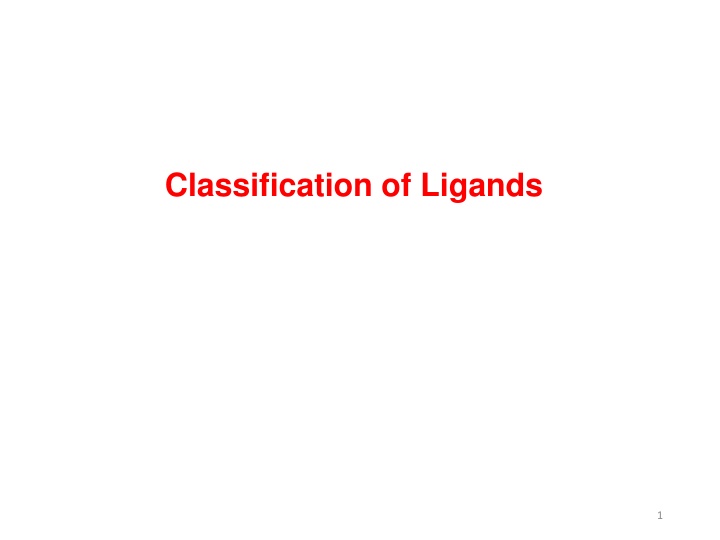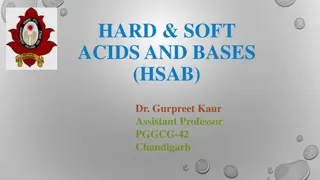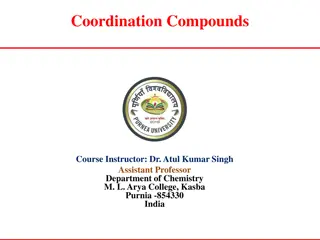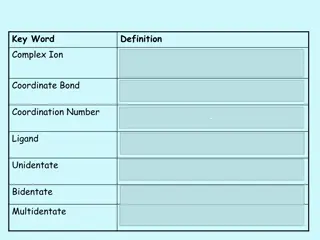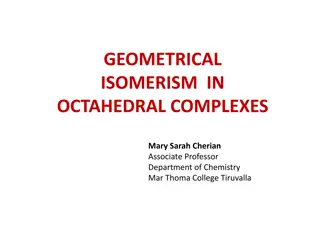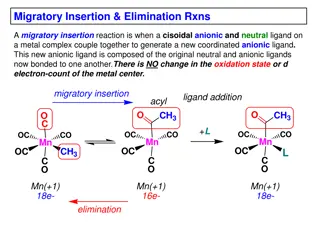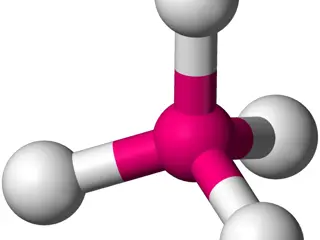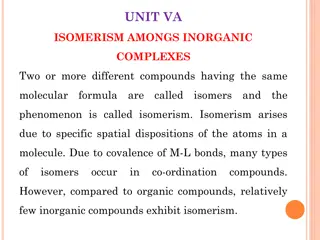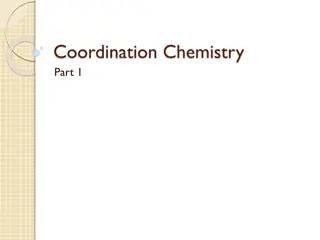Ligands and Metal Carbonyl Complexes: A Comprehensive Overview
Explore the classification of ligands in metal complexes, including alkyl, aryl, and carbonyl ligands. Learn about the unique properties of carbonyl ligands, their preparation methods, and the molecular orbital diagram illustrating CO-metal bonding interactions.
Download Presentation

Please find below an Image/Link to download the presentation.
The content on the website is provided AS IS for your information and personal use only. It may not be sold, licensed, or shared on other websites without obtaining consent from the author.If you encounter any issues during the download, it is possible that the publisher has removed the file from their server.
You are allowed to download the files provided on this website for personal or commercial use, subject to the condition that they are used lawfully. All files are the property of their respective owners.
The content on the website is provided AS IS for your information and personal use only. It may not be sold, licensed, or shared on other websites without obtaining consent from the author.
E N D
Presentation Transcript
Classification of Ligands -bonded Alkyl, Aryl, and Related Ligands complexes are rare compounds, in which the bonding electrons of a X H bond further participate in bonding with a metal center (X = H, Si, Sn, B, and P). The complexes thus exhibit an a skewed binding to a metal center with the hydrogen atom, containing no lone pair, being more close to the metal center and thereby resulting in a side on structure. Many times if the metal center is electron rich, then further back donation to the * orbital of the metal bound X H moiety may occur resulting in a complete cleavage of the X H bond. 2
Carbonyl Ligands Metal carbonyls are important class of organometallic compounds that have been studied for a long time. Way back in 1884, Ludwig Mond, upon observing that the nickel valves were being eating away by CO gas in a nickel refining industry, heated nickel powder in a stream of CO gas to synthesize the first known metal carbonyl compound in the form Ni(CO)4. The famous Mond refining process was thus born, grounded on the premise that the volatile Ni(CO)4compound can be decomposed to pure metal at elevated temperature. 3
Carbonyl Ligands The carbonyl ligand (CO) distinguishes itself from other ligands in many respects. For example, unlike the alkyl ligands, the carbonyl (CO) ligand is unsaturatedthus allowing not only the ligand to donate but also to accept electrons in its * orbital from d metal orbitals and thereby making the CO ligand acidic. The other difference lies in the fact that CO is a soft ligand compared to the other common and basic ligands like H2O or the alkoxides (RO ), which are considered as hard ligands. 4
Preparation of metal carbonyl complexes The common methods of the preparation of the metal carbonyl compounds are, 1.Directly using CO The main requirement of this method is that the metal center must be in a reduced low oxidation state in order to facilitate CO binding to the metal center through metal to ligand back donation. 5
Types of CO- Metal bonding interactions: M-C bond: C-O bond: COfreq: increases increases increases decreases increases decreases
Carbonyl Infrared (IR) Stretching Frequencies The position of the carbonyl bands in the IR depends mainly on the bonding mode of the CO (terminal, bridging) and the amount of electron density on the metal being -backbonded to the CO. The number (and intensity) of the carbonyl bands observed depends on the number of CO ligands present and the symmetry of the metal complex. There are also secondary effects such as Fermi resonance and overtone interactions that can complicate carbonyl IR spectra. O C O C M O C O C M M M 2 bridging M M 3 bridging terminal mode free CO COIR(cm-1) 2143 2120 - 1850 1850 - 1720 1730 - 1500 (for neutral metal complexes)
Electronic Effects on CO As the electron density on a metal center increases, more -back bonding to the CO ligand(s) takes place. This further weakens the C-O bond by pumping more electron density into the formally empty carbonyl * orbital. This increases the M-CO bond strength making it more double- bond-like, i.e., the resonance structure M=C=O assumes more importance. Based on CO IR stretching frequencies, the following ligands can be ranked from best -acceptor to worst: NO+ > CO > PF3 > RN C > PCl3 > P(OR)3> PR3 > RC N > NH3
Metal-ligand bonding can be divided into three basic classes: - donor e.g. H, CH3 (or any alkyl or aryl group, R), H2O, NH3, NR2(bent) - donor, acceptor (sometimes referred to as -acceptors or -acids ) e.g. CO, CN, NO, H2, C2H4, N2, O2, PR3, BR2 - donor, donor (sometimes referred to as donors ) e.g. F, Cl, Br, I, O, OR, S, SR, N, NR2(linear), NR (bent and linear), P, 3-C3H5, 5-C5H5, 6-C6H6 In terms of bond strength the -bond is much more important than -bonding (donor or acceptor)
Cationic 2e- donor: NO+(nitrosyl) Neutral 2e- donors: PR3 (phosphines), CO (carbonyl), R2C=CR2 (alkenes), RCCR (alkynes, can also donate 4 e-), NCR (nitriles) Cl-(chloride), Br-(bromide), I-(iodide), CH3-(methyl), CR3-(alkyl), Ph-(phenyl), H-(hydride) The following can also donate 4 e- if needed, but initially count them as 2e- donors (unless they are acting as bridging ligands): OR-(alkoxide), SR- (thiolate), NR2-(inorganic amide), PR2-(phosphide) Anionic 2e- donors: C3H5-(allyl), O2-(oxide), S2-(sulfide), NR2-(imido), CR22-(alkylidene) and from the previous list: OR-(alkoxide), SR- (thiolate), NR2-(inorganic amide), PR2- Cp-(cyclopentadienyl), N3-(nitride) Anionic 4e- donors: Anionic 6e- donors:
Classification of ligands x eta-x was originally developed to indicate how many contiguous donor atoms of a p-system were coordinated to a metal center. Hapticity is another word used to describe the bonding mode of a ligand to a metal center. An h5-cyclopentadienyl ligand, for example, has all five carbons of the ring bonding to the transition metal center. x values for all-carbon based ligands where the x value is odd usually indicate anionic carbon ligands (e.g., 5-Cp, 1-CH3, 1-allyl or 3-allyl, 1-CH=CH2). The # of electrons donated (ionic method of electron counting) by the ligand is usually equal to x + 1. Even x values usually indicate neutral carbon p-system ligands (e.g., 6- C6H6, 2-CH2=CH2, 4-butadiene, 4-cyclooctadiene). The # of electrons donated by the ligand in the even (neutral) case is usually just equal to x.
Classification of Ligands by donor atoms 19
Classification of Ligands by donor atoms: Ligand is a molecule or an ion that has at least one electron pair that can be donated. Ligands may also be called Lewis bases; in terms of organic chemistry, they are nucleophiles . Metal ions or molecules such as BF3(with incomplete valence electron shells (electron deficient) are called Lewis acids or electrophiles). 20
Hydrocarbon complexes An organometallic compound is one which has metal-carbon bonds, and between one and eight carbon atoms in a hydrocarbon ligand bond to a metal. Hapticity describes the number of atoms in a ligand that have direct coordinative interaction with the metal and the number is added to . An example is 5 5(pentahapto)-cyclopentadienyl (Table below). Table Hapticity and number of donating electrons of hydrocarbon ligands Name Hapticity Number of electrons Example Alkyl 1 W(CH3)6 1 Alkylidene 2 Cr(CO)5{C(OCH3)C6H5} 1 Alkene 2 K[PtCl3(C2H4)] 2 -allyl 3 Ni( 3-C3H5)2 3 Diene 4 Fe(CO)3( 4-C4H6) 4 Cyclopentadienyl 5 Fe( 5-C5H5)2 5 Arene 6 Cr( 6-C6H6)2 6 Tropylium 7 V(CO)3( 8-C7H7), 7 Cyclooctatetraene 8 U( 8-C8H8)2 8 21
Metal Alkyls With this post we finally reach the defining ligands of organometallic chemistry, alkyls. Metal alkyls feature a metal-carbon bond and are usually actor ligands, although some alkyl ligands behave as spectators. Reactivity decreases as the metal's electronegativity increases. Values given are Pauling electronegativities. The hybridization of the carbon atom is also important, and the trend here follows the trend in nucleophilicity as a function of hybridization in organic chemistry. sp-Hybridized ligands are the least nucleophilic, followed by sp2 and sp3 ligands respectively. Note that this trend is similar to the nucleophilicity of carbanions as a function of hybridization. 22
allyl complexes If an allyl group, CH2=CH-CH2-, is bonded to a metal via a carbon atom, it is a 1-electron ligand like an alkyl group. If the double bond delocalizes, three carbon atoms bond to the metal simultaneously as a 3-electron ligand. This is also an odd electron and formally anionic ligand and is stabilized by being coordinated to the metal. Pd(C3H5)(Ac)(PPh3), Co(C3H5)3, etc are well-known examples. Since 1, 2, and 3coordination modes are possible in the catalytic reactions of unsaturated hydrocarbons, various reactions occur. 23
cyclopentadienl complexes The cyclopentadienyl ligand, C5H5, is abbreviated as Cp. C5Me5, in which the hydrogen atoms of Cp are replaced with methyl groups, is a useful ligand called Cp star and is denoted by Cp*. Ferrocene, Cp2Fe, is a very stable orange-colored iron compound in which two cyclopentadienyl groups are bonded to iron. It was discovered independently in two laboratories, but the discoverers proposed incorrect structures. The correct structure was clarified by the group of G. Wilkinson, who won a Nobel Prize (1973) 24
Olefin complexes Zeise's salt, K[PtCl3(C2H4)], is the oldest known organometallic compound and was synthesized and analyzed in ca. 1825 by Zeise. An olefin is a 2- electron ligand and there are many olefin complexes in which the central metal is in a relatively low oxidation state. Dienes or trienes with two or more double bonds coordinate to a metal as 4-electron or 6-electron ligands. Fe(CO)3(C4H6) and Ni(cod)2, in which a butadiene or cyclooctadienes (cod) are coordinated to the metal, are well known examples. Since cyclooctadienes are easily eliminated from Ni(cod)2, it is conveniently used for generating atomic, zero valent nickel. This complex is sometimes called naked nickel Cyclooctadienes (cod) 25
Arene complexes Aromatic compounds are 6-electron donors that coordinate to transition metals in the 6coordination mode with six carbon atoms. Bisbenzenechromium, Cr(C6H6)2, is a typical example of such a compound. The compound is prepared by reducing chromium chloride in benzene and it has a sandwich structure in which a chromium atom is inserted between two benzene rings. When a benzene ligand is replaced by three carbonyls, Cr(CO)3(C6H6) is obtained. 26
Some electron donors ligands are classified as below: (1) One electron donor: when the metal ions attached with one carbon such as: 27
(2) two electrons donor: two carbon bonded ligands are those ligands in which two carbon atoms of the same ligand are bonded to the metal atom as 28
(3) Three electrons donors: three carbon bonded ligands are those ligands in which three carbon atoms of the same ligand are bonded to the metal atom 29
Six electrons donor Seven electrons donors 32
Neutral atom method: Metal is taken as in zero oxidation state for counting purpose Oxidation state method: We first arrive at the oxidation state of the metal by considering the number of anionic ligands present and overall charge of the complex Suggestion: Focus on one counting method till you are confident 35
